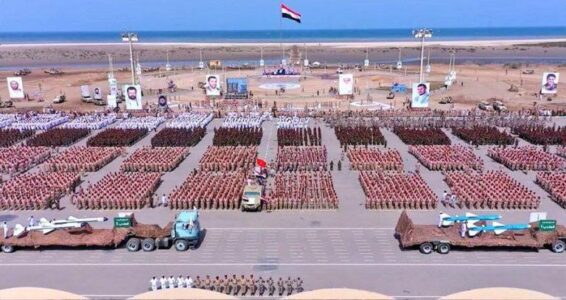
The Houthis in Yemen unveil their new anti-ship missiles
At the Red Sea coastal city of Hudaydah on 1 September, the Houthi Movement, which is backed by Iran and controls western Yemen, including the capital Sana, hosted a massive military parade dubbed “The Promise of the Hereafter”. The organization’s top brass took part in the military parade, particularly Mahdi al-Mashat, the chairman of the Houthi Supreme Political Council. Several anti-ship missiles allegedly manufactured in Yemen, which have never been seen before, made their debut during the ceremony, which also featured over 25,000 soldiers of the Houthi-led Supreme Political Council and a significant amount of military equipment.

The new Houthi anti-ship missile Falaq 1 / From the Houthi media
The first new weapon displayed in the parade square was a surface-to-sea ballistic missile called Falaq 1, which is claimed to be entirely manufactured in the country. Although the Ansarullah organization (the Houthi Movement) claimed that the missile in question was entirely produced in Yemen, images from the parade revealed that the Falaq 1 greatly resembles Iran’s Khalij Fars (Persian Gulf) anti-ship missile. The missile’s exact technical specifications are currently unknown. However, according to information provided to the press by Sanaa forces, the 6-meter-long missile has a range of more than 200 kilometers (140 miles). It is a single-stage, solid-fuel missile that can track targets visually and thermally using an electro-optical seeker located in the nose.

The Al-Mandeb 2 anti-ship cruise missile was also displayed at the military parade. The Houthi Movement claimed that this new missile, like the Falaq 1, was entirely manufactured in Yemen, but images revealed similarities between the missile in question and Iran’s long-range Noor and Qader anti-ship cruise missiles. These Iranian anti-ship cruise missiles were developed as a result of reverse engineering studies on the C-802 anti-ship missile, which Iran acquired from China at the time. The technical specifications of the missile in question are unknown, but according to the information released by the Sanaa forces, the Al-Mandeb 2 with a length of 7 meters and a diameter of 0.36 meters has an operating range of 300 kilometers (190 miles). Al-Mandeb 2, a long-range, winged missile with high targeting accuracy, is guided by an active radar seeker, according to the Ansarullah organization. The Mandeb 1 missile, which has been used by the Houthis since 2017, was also displayed at the military parade alongside Al-Mandeb 2. These are copies of China’s C-801 subsonic anti-ship cruise missile, which the Houthis seized from Yemeni Navy stockpiles during the Yemeni civil war that began in late 2014.
At the military parade, Rubezh coastal defense systems and Soviet P-15M Termit anti-ship missiles were also displayed. With these images, it was revealed that the Houthis had reactivated the Soviet-made Rubezh coastal defense systems. According to Ansarullah, these old-style missiles are now operational thanks to the efforts of Yemeni engineers. These missiles are also among the systems seized by the Houthis from Yemeni Navy stockpiles during the Yemeni civil war.
The United Nations (UN) Mission to Support the Hudayda Agreement (UNMHA) in Yemen expressed concern about the Iranian-backed Houthis holding a military parade in Yemen’s Hudaydah province in the country’s west. The statement, which noted that the mission is closely monitoring the situation, urged the Houthis to fully comply with their obligations under the agreement, particularly in terms of keeping the City free of military manifestations. The statement emphasized that every effort must be made to ensure the protection of the local population through the agreement’s full implementation.
Yemeni Houthi Movement Leader Abdul-Malik al-Houthi stated, however, that the parade titled “The Promise of the Hereafter” is intended to comfort the people while also sending a message to their enemies. Al-Houthi added that the army’s development of war capabilities in the fields of naval, air, ground, missile, and equipment production is for the country’s defense, and that their enemies’ efforts to destroy the army’s strength and take away Yemen’s power will fail.
Source: Overt Defense






You must be logged in to post a comment.